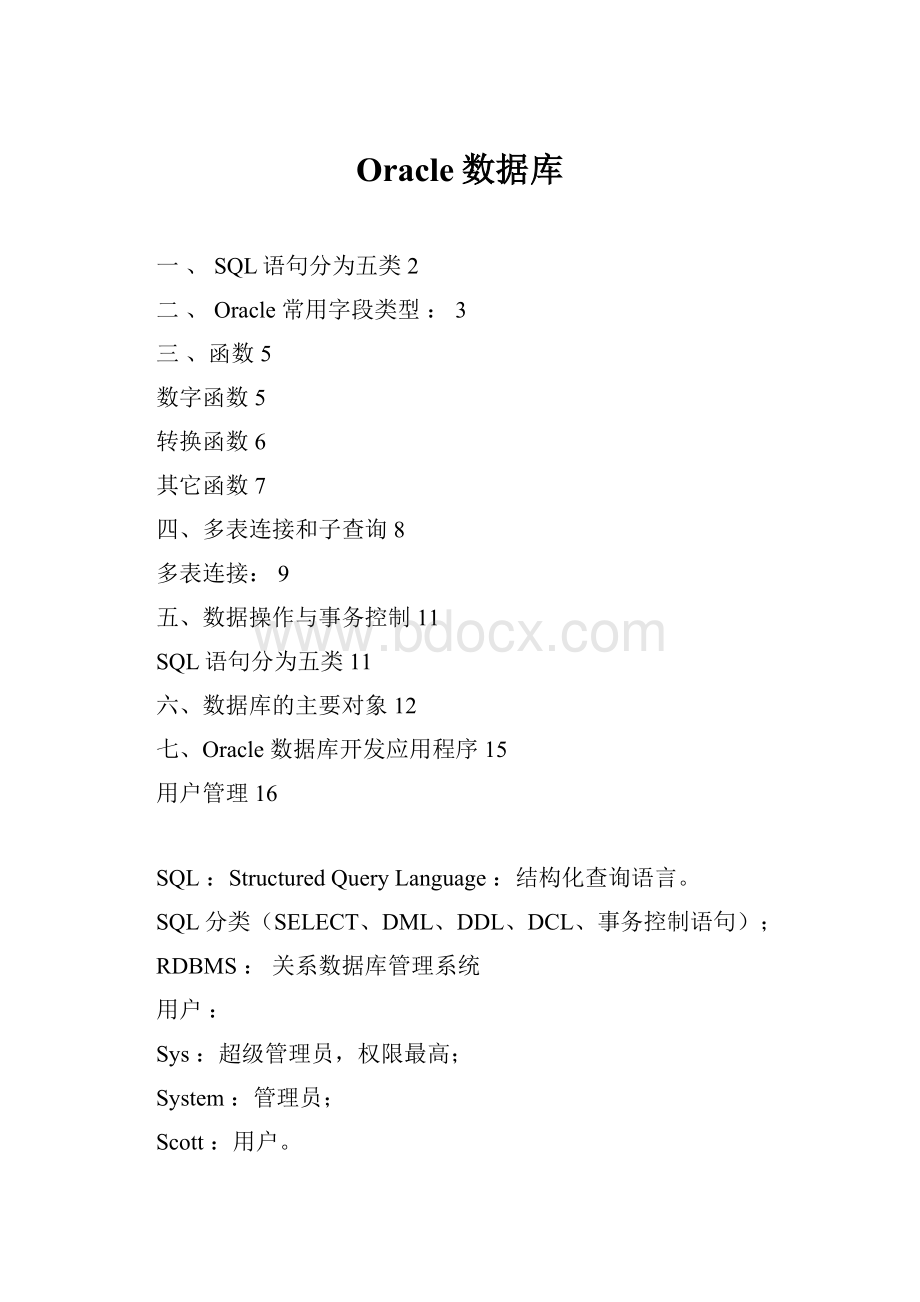Oracle数据库.docx
《Oracle数据库.docx》由会员分享,可在线阅读,更多相关《Oracle数据库.docx(23页珍藏版)》请在冰豆网上搜索。

Oracle数据库
一、SQL语句分为五类2
二、Oracle常用字段类型:
3
三、函数5
数字函数5
转换函数6
其它函数7
四、多表连接和子查询8
多表连接:
9
五、数据操作与事务控制11
SQL语句分为五类11
六、数据库的主要对象12
七、Oracle数据库开发应用程序15
用户管理16
SQL:
StructuredQueryLanguage:
结构化查询语言。
SQL分类(SELECT、DML、DDL、DCL、事务控制语句);
RDBMS:
关系数据库管理系统
用户:
Sys:
超级管理员,权限最高;
System:
管理员;
Scott:
用户。
Oracle卸载过程:
_______________________________________________________________________________
1、停止Oracle所有的服务;
2、卸载所有Oracle所有产品,开始—>程序—>Oracle-Orahome10g—>OracleInstallationProducts—>UniversalInstaller;
3、运行regedit,选择HKEY_LOCAL_MACHINE—>SOFTWARE,删除所有ORACLE入口;
4、运行regedit,选择HKEY_LOCAL_MACHINE—>SYSTEM—>CurrentContralSet—>Service,删除所有ORACLE入口;
5、运行regedit,选择HKEY_LOCAL_MACHINE—>SYSTEM—>CurrentContralSet—>Service—>Eventlog—>Application,删除所有ORACLE入口;
6、删除Oracle目录;
7、重启计算机(若有不可删除的,重启之后即可删除)。
_______________________________________________________________________________
一、SQL语句分为五类
查询语句:
Select
DML语句(数据操作语言):
Insert/Update/Delete/Merge
DDL语句(数据定义语言):
create、alter、drop、truncate
DCL语句(数据控制语言):
grant、revoke
事务控制语句:
commit、rollback、savepoint
二、Oracle常用字段类型:
Char(n):
定长字符串
Varchar2(n):
变长字符串
Number(m,p):
数字类型
Date:
日期类型
1、创建表格
CREATETABLEstudent
(st_classchar(4),
st_numchar(10),
st_namevarchar2(4),
st_sexchar
(2),
st_agenumber(3,0)
)
2、显示表格框架
describe/descstudent;
3、插入数据
INSERTINTOstudent(st_class,st_num,st_name,st_sex,st_age)
VALUES('J02','0245639','哈哈','男',15);
4、显示所有数据
select*fromstudent
5、删除表格
DROPTABLEstudent;
6、连接符||和字段别名表示
selectfirst_name||last_name||'的工资是:
'||salary员工的工资fromemployees
7、去掉重复值
selectdistinctdepartment_idfromemployees
8、筛选
selectfirst_name,last_name,salaryfromemployees
wherefirst_name='S';/wheresalary>1000;
<>:
不等于
between…and…在某范围之内
in(list)字符串在那个之间
like(%、_)
is[not]null;是否为空
and,or,not。
连接关系,优先级not>and>or;
在一定范围值内:
数字用wheresalarybetween2000and2300
字符串用wherefirst_nameIN('F');
模糊查询:
wherefirst_namelike'joan%'
wherefirst_namelike'joan_'
wheredepartment_idisnull/notnull
满足两个条件,用AND连接,满足其中一个,用OR连接。
wheredepartment_id=1
andsalary>1000
9、排序
升序:
orderbydepartment_idasc(asc默认可以不写)
降序:
orderbysalarydesc
多种排序:
orderbydepartment_idasc,salarydesc
10、注释语句(--…..)
select*fromstudent--查找表中所有内容
11、空指针:
null。
12、起别名
(1)selectfirst_nameAS“姓名”,last_name,salaryfromemployees
(2)selectfirst_nameAS姓名,last_name,salaryfromemployees
(3)selectfirst_name姓名,last_name,salaryfromemployees
13、重命名表格:
renameemployees(旧表名)toemployee(新表名);
14、向表中增加字段:
altertableemployeesadd(namevarchar2(20));
15、从表中删除字段:
altertableemployeesdrop(name);
16、删除记录:
deletefromemployeeswhereemployee_id=7;
17、删除表中全部记录(清空表格):
deletefromemployees;
18、数据修改:
updatesalary
sethightest_level=4000
wheregrade_level=5
19、修改字段属性:
altertableemployeemodify(department_idvarchar2(30)notnull)
三、函数
SQL函数分类:
单行函数,多行函数;
单行函数分为:
字符函数、数字函数、日期函数、转换函数和其它函数;
字符函数
1、大小写转换函数:
lowerupperinitcap
selectfirst_namefromemployeewherelower(first_name)='jacky'
selectfirst_namefromemployeewhereupper(first_name)='JACKY'
selectfirst_namefromemployeewhereinitcap(first_name)='Jacky'
2、字符处理函数
Concat:
连接两个字符串
selectconcat(last_name,first_name)fromemployee
substr:
取出字符串的字符串
selectfirst_name,substr(first_name,1,3)fromemployee
length:
求字符串长度
selectfirst_name,length(first_name)fromemployee
instr:
找到字符串的位置
selectfirst_name,instr(first_name,'c')fromemployee
lpad|rpad:
字符串填充补位函数
selectfirst_name,lpad(first_name,6,'*')fromemployee
trim(‘’fromfirst_name):
截取字符串两侧的字符(只能截取字符串两端的字符,不能截取中间的字符)
ltrim(‘marry’,‘ma’),截取字符串左端的字符,结果为:
ry,可以截取多个左端的字符;
rtrim(‘marry’,‘ry),截取字符串右端的字符,结果为:
ma,可以截取多个右端的字符;
selectfirst_name,ltrim(first_name,‘Ja’)fromemployee
selectfirst_name,rtrim(first_name,‘cy’)fromemployee
replace:
替换字符串
selectfirst_name,replace(first_name,'Ja','DD')fromemployee
数字函数
Round:
数字四舍五入
Selectsalary,round(salary,2),round(salary,1),round(salary,0),round(salary,-1),round(salary,-2)fromemployee
whereemployee_id=201001
trunc :
直接截掉数字
selectsalary,trunc(salary,2),trunc(salary,1),trunc(salary,0),trunc(salary,-1),trunc(salary,-2)fromemployee
whereemployee_id=201001
mod:
求余数(取模)
selectsalary,mod(salary,10)fromemployee
whereemployee_id=201001
日期函数
Sysdate:
得到当前系统的时间(默认日期格式:
DD-MON月-YY)
selectsysdatedual;
日期加减一个数字得到一个新日期,即增加或减少多少天
selecthire_date,hire_date+10,hire_date-10fromemployee
日期和日期之间不能相加,能够进行相减!
相减得到两个日期相差的天数!
Month_Between:
比较日期之间相差的月份
selectmonths_between(sysdate,hire_date)fromemployee
add_months:
日期加上或减去几个月
selecthire_date,sysdate,add_months(hire_date,5)fromemployee
selecthire_date,sysdate,add_months(hire_date,-5)fromemployee
next_day:
取得从当前时期开始遇到的第一个指代星期几的日期
selecthire_date,sysdate,next_day(sysdate,4)fromemployee
last_day:
指定日期所在月份最后一天的日期
selecthire_date,sysdate,last_day(sysdate)fromemployee
round:
取得按年或者月四舍五入得到的次年日期,年的四舍五入以每年六月为基准,月的四舍五入以每月的15号为基准。
selecthire_date,sysdate,round(sysdate,'year')fromemployee
selecthire_date,sysdate,round(sysdate,'month')fromemployee
trunc:
取得按年或月截取获得的新日期
selecthire_date,sysdate,trunc(sysdate,'year')fromemployee
selecthire_date,sysdate,trunc(sysdate,'month')fromemployee
转换函数
对日期进行to_char转换
selectsysdate,to_char(sysdate,'YYYY-MM-DD')fromemployee
对数字进行to_char转换:
9不强制显示,0强制显示,L显示本地符号。
selectsalary,to_char(salary,'$999,999,999.99')fromemployee
selectsalary,to_char(salary,'L00,000.00')fromemployee
to_date函数
selectto_date('11-10月-10')fromemployee
selectto_date('2010-10-11','YYYY-MM-DD')fromemployee
to_number函数
selectto_number('12345')*10fromemployee、
其它函数
nvl(expr1,expr2):
用于将控制转换为一个替换值
selectmanager_id,nvl(manager_id,12345)fromemployee
nvl2(expr1,expr2,expr3):
如果expr1不为null,返回expr2,否则返回expr3
selectmanager_id"前",nvl2(manager_id,12345,4567)fromemployee
nullif(expr1,expr2):
比较两个表达式,如果相等返回null,如果不相等返回第一个表达式的值。
selectlength(first_name),length(last_name),nullif(length(first_name),
length(last_name))fromemployee
coalesce(expr1,expr2,….exprn):
查找表达式莉第一非空值表达式,并返回此表达式的值(括号里面表达式必须是同一类型的)。
selectcoalesce(email,last_name,first_name)fromemployee;
条件表达式(实现if-then-else的逻辑):
使用两种方法:
case表达式,decode函数
case表达式:
selectemployee_id,first_name,department,salary,
casedepartmentwhen1thensalary+100
when2thensalary+200
when3thensalary+300
elsesalary+500
end"NEWSALARY"
fromemployee;
decode函数:
selectemployee_id,first_name,department,salary,
decode(department,1,salary+100,2,salary+200,3,salary+300)"NEWSALARY"fromemployee;
分组函数
1、分组函数对多行输入值进行运算,得到多行对应的单个结果
AVG():
计算平均值,distinct去掉重复值后再进行计算。
selectavg(salary)"平均工资"fromemployee;
selectavg(distinctsalary)"平均工资"fromemployee;
count:
计算总个数非空的才计算在内。
selectcount(*)fromemployee;
selectcount(*)fromemployeewheredepartment=6;
注:
count(*)求出所有符合条件的记录数,count(字段)是求出所有符合条件并且字段值非空的记录数。
max(),min():
求最大值,最小值
selectmin(salary)fromemployee;
selectmin(salary)fromemployee;
sum():
求和
selectsum(salary)fromemployee;
2、使用groupby对数据进行分组
使用groupby可以将表分成多个组,groupby紧跟where语句之后,
分组函数在使用的时候,需要遵守一些规则:
I出现在select列表中的字段,如果出现位置不再组函数中,那么必须出现在groupby子句中。
selectdepartment部门,avg(salary)平均工资fromemployeegroupbydepartment;
II在group出现的字段可以不出现在查询语句中。
selectavg(salary)平均工资fromemployee
groupbydepartment;
IIIwhere子句中不允许出现出现组函数,组函数可以出现在查询列表中,或者groupby子句中,但是不允许出现在where子句中。
错误例子:
selectdepartment,avg(salary)fromemployeewhereavg(salary)>5000groupbydepartment;
3、使用having子句对分组结果进行限制
selectdepartment部门,avg(salary)平均工资fromemployee
groupbydepartmenthavingavg(salary)>3000;
四、多表连接和子查询
约束:
在表上强制执行的一些数据校验规则,被插入、修改或者删除的数据必须符合在相关字段上设置这些数据检验规则,也就是约束条件。
Oracle数据库中包括五类完整性约束:
1、NOTNULL非空:
只能定义在列级,保证列值不能为空。
2、UNIQUE唯一键:
保证值不允许重复(可以为空)。
3、PRIMARYKEY主键:
不允许有重复值,也不允许有空值。
4、FOREIGNKEY外键:
5、CHECK检查:
约束条件存放在数据字典中,同样需要命名;
约束条件命名有两种方式:
Oracle按照SYS-Cn的默认命名格式命名,或者有用户指定的约束条件命名。
在什么时候创建约束:
(1)、建表的时候
createtablestudent(numnumber(20)notnull,namevarchar2(20)notnull,sexvarchar2
(2),agenumber(3))
(2)、建表之后
查找定义的约束:
select*fromall_constraintswheretable_name='STUDENT'
删除约束:
altertablestudentdropconstraintSYS_C005402;
添加约束:
altertablestudentaddconstraintnum_uni_checkunique(num);
altertablestusubaddconstraintstu_sub_checkprimarykey(st_no,su_no)
创建外键连接:
createtablestusub(numnumber(20),sub_nochar(4),foreignkey(num)referencesstudent)
查询约束:
select*fromall_constraintswheretable_name='EMPLOYEE';
check约束:
createtablestuInfo(stu_idchar(10)primarykey,stu_namevarchar2(10)notnull,stu_agenumber
(2),constraintstu_age_checkcheck(stu_age>15))
启用约束:
altertablestuInfoenableconstraintstu_age_check;
关闭约束:
altertablestuInfodisableconstraintstu_age_check;
多表连接:
使用单个select语句从多个表中取出相关的数据。
selectdepartment.department_id,employee.em_namefromdepartment,employeewhereemployee.department_id=department.department_id;
使用别名:
selectd.department_id,e.em_namefromdepartmentd,employeeewheree.department_id=d.department_id;
注意:
一定要有where语句且where语句后面是正确的连接条件,如果漏写或者错误的连接条件,会产生错误的结果!
多表连接可以分为四类:
等值连接、非等值连接、外连接、自连接,还有SQL99新标准下的多表连接。
等值连接:
最常见的一种,连接条件中的两个字段通过等号连接建立等值关系。
Ø示例:
selectd.department_id,e.em_name,d.department_namefromdepartmentd,employeeewheree.department_id=d.department_id;
Ø通过and连接字句和查询条件
selectd.department_id,e.em_name,d.department_namefromdepartmentd,employeeewheree.department_id=d.department_idande.department_='1001';
Ø连接多个表:
通过and操作符连接,一般来说,n个表连接,至少需要n-1个连接。
selects1.st_name,s2.su_namefromstusubs3,students1,subjects2whe